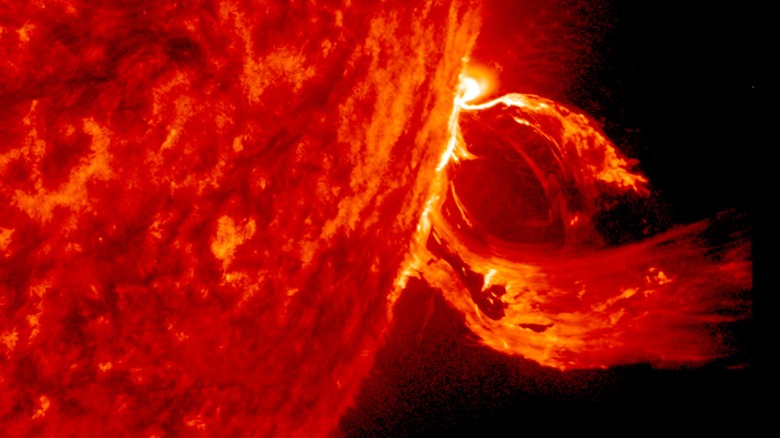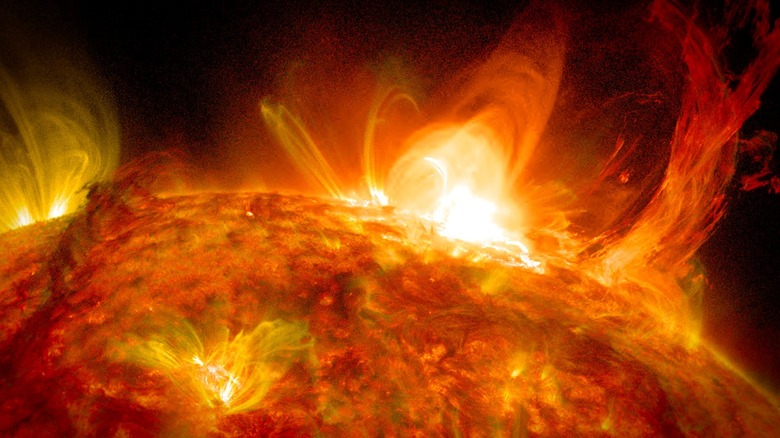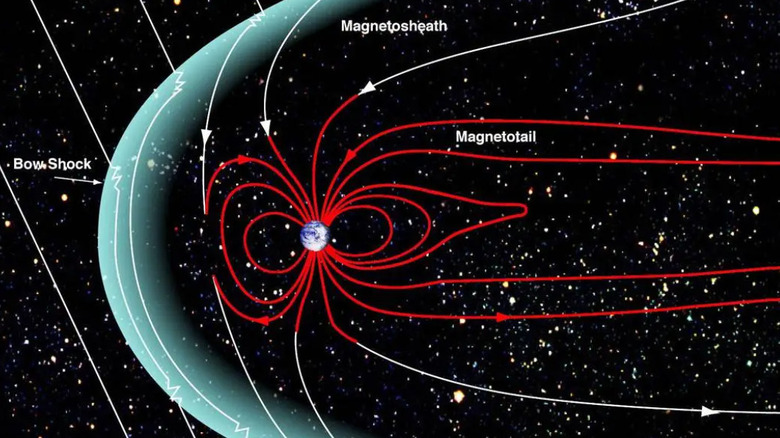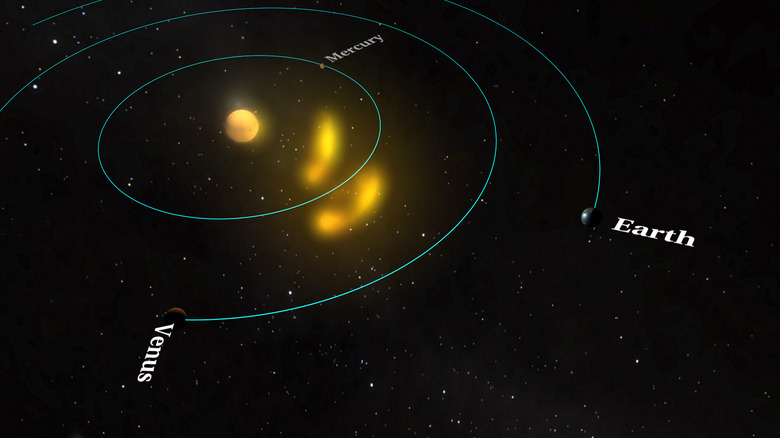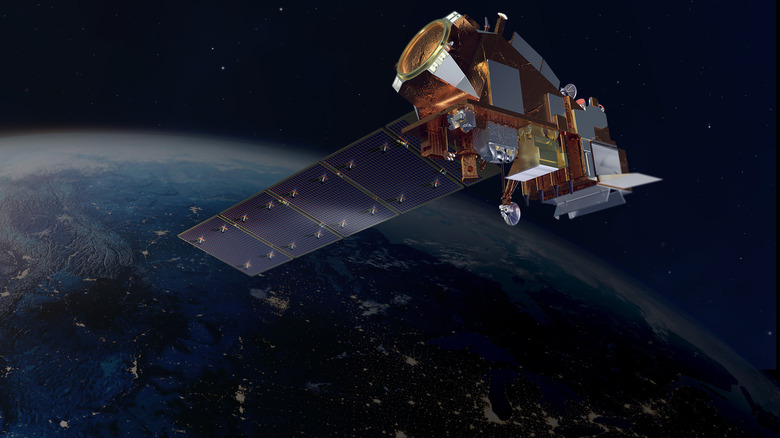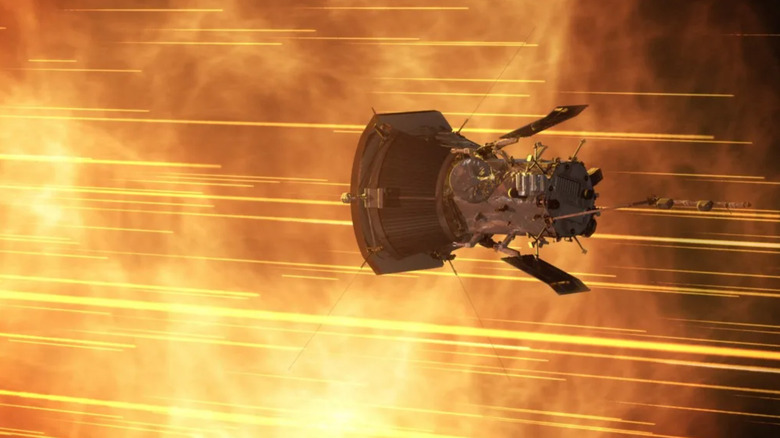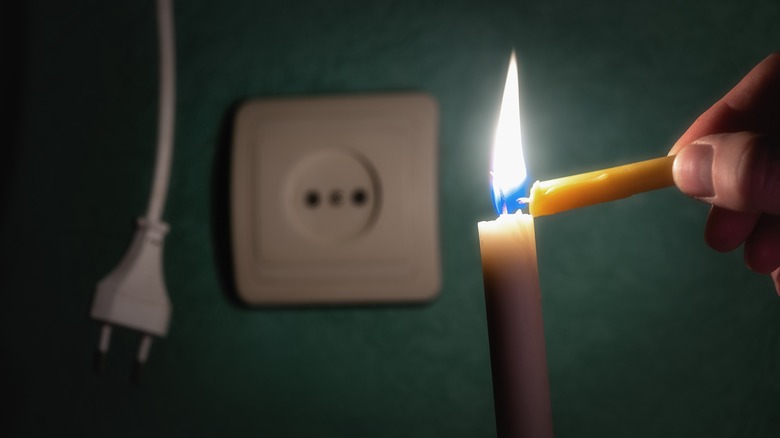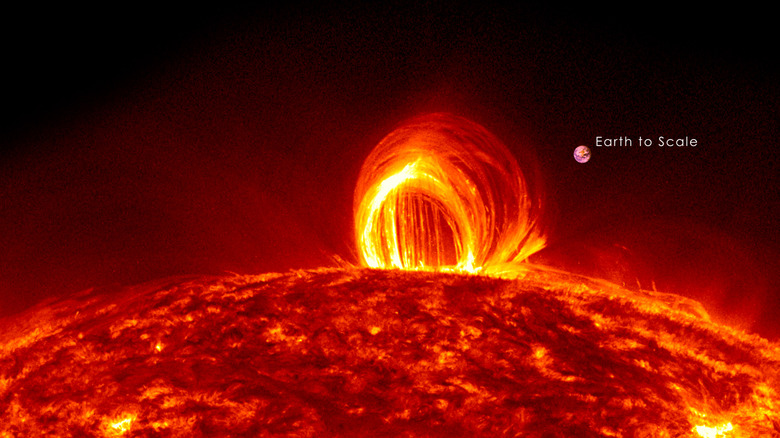How An Explosion From The Sun Could End The Digital Age
Fiction is filled with stories about death from above, space-based apocalypses that bring an end to human civilization, or threaten to. At this point, a last-ditch mission to stop an asteroid from destroying the planet has become a tired trope in movies.
There was a time when asteroids were a pretty scary idea. We knew they were out there, we knew they could hit us because it has happened before, and we knew there wasn't much we could do about it. Things aren't quite as frightening on the asteroid front these days. We've got a pretty good handle on what's out there and where it's headed, thanks to NASA's Center for Near-Earth Object Studies (CNEOS). If something did decide to take a run at us, the recent success of the DART mission suggests we might be able to mount a defense.
Pretty soon, the threat of an asteroid impact might be a thing of the past, but that doesn't mean the skies will be safe. Roughly once a decade, the Sun throws a series of temper tantrums capable of supercharging the Earth's atmosphere. These geomagnetic storms don't pose much of a threat to humans directly, but if we got hit by a particularly powerful solar storm, it could set our electrical infrastructure back centuries.
The Sun's 11-year solar cycle
Taken at face value, the Sun looks like an unchanging orb glowing in the daytime sky. In actuality, the Sun goes through a cyclical ebb and flow of activity every 11 years. If you could see the Sun up close, you would see a hot mass of charged plasma, roiling and mixing together. All of that mixing generates a powerful magnetic field made of constantly tangling field lines.
The magnetic situation on the Sun is chaotic, and it completely changes direction every cycle, when the north and south magnetic poles switch places. Throughout each cycle the Sun goes from Solar Minimum, a period of low surface activity, to Solar Maximum, a period of increased surface activity, and back again.
We're currently moving toward Solar Maximum of Solar Cycle 25 (the twenty-fifth cycle on record) during which sunspot activity will reach its peak. Those sunspots are indicative of intense localized magnetic activity, lowering the temperature of the nearby plasma and making it appear dark. Sometimes the magnetic field lines are powerful enough to fling bits of the Sun out into space, in the form of solar flares or coronal mass ejections.
Solar flares vs. coronal mass ejections
In everyday conversation, people often use the term "solar flare" as a catch-all for anything that the Sun shoots out into space. Solar flares certainly exist, but they aren't much of a threat. A solar flare pales in comparison to its much more dramatic and more powerful sibling, the coronal mass ejection (CME).
Solar flares are a gentler sort of solar eruption which happens when magnetic field lines get tangled up and release a bunch of energy. We see them as brilliant flashes of light that travel across space at the speed of light. As soon as we see them, they are already here, and they don't pose much of a threat to us or our machines. Coronal mass ejections, on the other hand, are much larger and much more powerful.
Rather than an intense burst of light and energy, CMEs are actual chunks of the Sun, blobs of charged plasma flung away from the surface. They travel at sub-light speeds, meaning they can take a few days to cross the 93 million miles to Earth. CMEs travel away from their point of origin in a straight line and sometimes that line leads directly to Earth. They are among the most powerful explosions our solar system has to offer, and we are lucky to be (mostly) protected.
Earth's magnetic field, a planetary force field
The same magnetic forces at play on the Sun are also in action on Earth, to a smaller degree. Activity in the Earth's core generates a magnetosphere that envelops the planet, protecting us from the more violent effects of solar radiation. CMEs from the Sun hit the Earth fairly frequently, and more often toward Solar Maximum. Almost without exception, these events pass without anyone on the ground really noticing, and that's because of the Earth's magnetic field.
If you've ever tried to push two magnets together, you'll have some idea of what's going on. When CMEs get close to the planet, their magnetic charge is repelled by the Earth's magnetosphere. Most of the time, any interaction happens high overhead and stops before it impacts anything at ground level. Because of the intense magnetic forces at play, most of the charged particles from the Sun concentrate at Earth's poles where the magnetic field is the strongest.
While Earth's magnetic field is a formidable protector, it isn't impervious. Activity from the Sun and from inside the Earth can impact how it behaves, and how well it deflects outside threats. And the stronger the solar outburst, the deeper it penetrates our defenses.
Auroras: the Northern and Southern Lights
When charged particles from the Sun get within spitting distance of the Earth, they bounce up against the magnetic field. Most of those particles will get bound up or bounced away, but some of them will slide down the magnetic field lines toward the poles and into the atmosphere. The resulting light shows have different names depending on the hemisphere, aurora borealis or Northern Lights in the north and aurora australis or Southern Lights in the south, but they are two instances of the same phenomenon.
When charged particles punch through the planet's magnetic barricade, they excite (add energy) to atoms in the upper atmosphere and make them glow. If you've ever seen a neon sign at work, you've got a pretty good idea of what's going on. Inside a neon lamp, trapped gas gets excited and emits a color. If sign makers want different colors, they fill the tubes with different gasses. Something similar happens in the sky during an aurora.
The lines of an aurora are created by the magnetic field itself, but the colors vary depending on the molecules in the atmosphere. On Earth, the atmosphere is made mostly of nitrogen, which glows blue when charged, and oxygen, which glows green or red.
The Carrington Event
In 1859, the Earth was struck by a particularly powerful blast from the Sun, triggering a correspondingly powerful geomagnetic storm. It has become known as the Carrington Event, named for Richard Carrington, the astronomer who observed the solar explosion which likely caused the ensuing mayhem.
Scientists have estimated that the 1859 solar storm was the most powerful in the last 500 years and we're pretty lucky it happened when it did. The most immediate consequence was a phenomenon of intense auroras seen all over the world. In some locations, people reported auroras so bright that they thought the Sun was rising several hours early. More dramatic consequences took place at the telegraph office.
In a cruel twist of fate, the negative consequences of geomagnetic storms preferentially impact technology. Anything that's operating on electricity or magnetism can be influenced, and the Carrington Event showed up right near the beginning of our love affair with electricity. There were reports at the time of telegraph machines throwing sparks and lines bursting into flames. There was so much energy in the atmosphere that telegraph operators in Boston reportedly discovered they could unplug the usual power source and transmit to Portland, Maine using just the energy in the air.
Earth narrowly missed another Carrington Event in 2012
As previously mentioned, CMEs are a fairly common occurrence but the Carrington Event shows us that some are significantly more powerful than others. The good news is that in order for us to be in trouble, one of those strong CMEs needs to be pointed right at us.
In 2012, astronomers observed a CME so powerful that it would have made Carrington look silly in comparison. We only avoided disaster because the explosion fired off in the slightly wrong (or right) direction. Astronomer David Baker told NASA that if it had happened a week earlier, it would have hit us. He also said that we're incredibly fortunate that didn't happen.
The folks alive during the Carrington Event got off light because their electrical and communications infrastructure was sparse. They didn't get hit too hard because there was so little to hit. If the 2012 eruption had played out differently, some experts have estimated we would have been picking up the pieces for years.
Space Weather Prediction Center
The Space Weather Prediction Center (SWPC) might sound like something from your favorite science fiction series but it's very real, and pretty serious. The SWPC operates under the umbrella of the National Oceanic and Atmospheric Administration (NOAA) and the National Weather Service.
Forecasters at SWPC use data from a collection of instruments on the ground and in space to assess the conditions on the Sun in close to real time. Then they use that data to predict the likely downstream effects on Earth. Forecasters look at previous data and compare the current data to similar situations in the past in much the same way more conventional weather forecasts are made.
The SWPC website provides up-to-date alerts on recent solar flares, CMEs, and predicted geomagnetic storms. Unlike conventional weather forecasts, you can't really see 10 days ahead. In most cases, we have a few days of advance warning. You'll also find information on geomagnetic storms, including the severity scale used to predict the probable impact of each solar bombardment.
The Parker Solar Probe
We still have a lot to learn about what's going on inside the Sun and how it impacts surface behavior. Unfortunately, the Sun isn't exactly the sort of place you can easily visit, but that hasn't stopped NASA from trying. The Parker Solar Probe (PSP) is designed to get up close and personal with the Sun in an effort to better understand it.
Over the course of its years-long mission, the PSP has slowly wound its way closer to the Sun's surface, using gravity assists from Venus to get closer on each pass. The probe's incredible heat and radiation shield is 4.5 inches of carbon-composite material, capable of protecting the craft as it flies through the outer fringes of the Sun itself.
Why go to all that trouble? The PSP's primary mission is a better understanding of the solar wind and improved methods for forecasting solar activity. Its onboard instruments are specially chosen for that task. They are designed to measure magnetic fields, plasma, and energetic particles, and capture images of the solar wind at its source.
What would happen if a Carrington-level CME hit today?
If something like Carrington or the 2012 near-miss were to sucker punch us today, the effects could be catastrophic. A 2013 study examining the near-miss estimated that it might have been even stronger than Carrington if it had fired off a week or so earlier, and it might have taken years to get through the aftermath. The economic impact could have been in excess of $2 trillion, according to NASA.
The same study outlines the layers of devastation. First, powerful X-rays would have arrived, knocking out radio communications and fiddling with our GPS systems. Next, a wave of charged particles would have arrived and fried satellites. Finally, the CMEs would have struck, flooding the atmosphere with energy. Electrical transformers, which are difficult to repair or replace, might have been destroyed by the influx. Anything that plugs into the grid or relies on electrical power would have shut down.
In the years since 2012, and certainly in the years since Carrington, we have only become more dependent on our gadgets, more entrenched into an electrical way of life. If one of these superstorms struck today, NASA says it would be like going back to the 18th century.
What are the odds of an electrical apocalypse?
The spookiest part about geomagnetic storms is that if a CME of considerable strength were on a collision course with Earth, there's nothing we could do to stop it. Unlike asteroids, you can't smash a spacecraft into them and nudge them out of the way. At best, we'd get a few days of advance warning to make preparations. Those preparations are the only things that would stand between us and the fried skeleton of our once-proud grid system, which is why better methods of prediction are so important.
The question then becomes one of probability, and those numbers are difficult to crunch. For one thing, potentially catastrophic CMEs aren't that frequent, so they're difficult to study. Taking into account previously observed space weather, predictive scientist Pete Riley took a stab at figuring out the odds of coronal calamity.
Riley focused on characteristics like flare intensity and CME speeds to narrow in on the odds of extreme solar events. The good news is, he found an inverse relationship between frequency and power. Put simply, weaker storms are common and strong ones are less frequent, that means Carrington-level events are uncommon — but not that uncommon. Riley estimated the likelihood of a Carrington-level CME at about 12% per decade. That's basically the equivalent of rolling an eight-sided die once a decade to determine the continued existence of our current level of technology.
